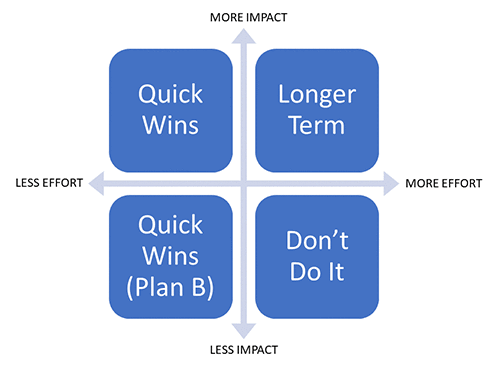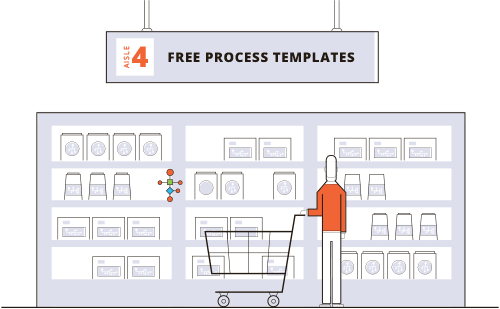Workflow Software Success Means Setting Yourself Up for Quick Wins
By Mike Raia ![]() | Published July 16, 2019
| Published July 16, 2019
Grab that low-hanging fruit!
Whether you're working on your first-ever large-scale workflow automation software project or you've just started another for a new set of stakeholders, it will benefit you to focus on a few quick wins before delivering a large-scale process implementation. The reasons for this are numerous and the benefits can be significant.
Why Are Quick Workflow Wins Important to Your Success?
A few reasons why quick wins make sense, especially when there's a complex, long-term project ahead.
1. Providing Motivation
The reason you bought in workflow automation software was to fix or improve workflow deficiencies. Why not prove that you and your team can, indeed, fix real problems by automating a few simple processes while you work on the larger scale workflow issues? This can provide a return (financial or employee morale) right away.
2. Encouraging Social Proof
Whether or not you were involved in the decision to bring in workflow automation software, you'll want to build social proof around the project. "Social proof" refers to the fact that when people see other people doing something, they're more likely to do it themselves. As you build and implement new, automated processes and they make some peoples' work lives easier, others will begin to recognize the value and participate. In many cases, staff will come to you and ask if you can help automate their processes. We've seen this happen many times. In fact, several of our customers have built processes that allow people to request a process be automated! Pretty meta, eh?
3. Building Familiarity
Once you've had some success using your workflow automation software, not only will you and the team have burgeoning confidence in your skills, you will have learned a lot about what to do and what not to do on the next project. This means that each project will get easier and the results will be better. String together 4-5 small projects and you'll be hitting the ground running.
You will also help your users become familiar with the system by going this route. Small wins that make their lives easier will help reduce the change anxiety some may feel. If they slowly begin to see the new system as helping them with their day-to-day work, they will be less likely to feel threatened as new, larger-scale automation is rolled out.
4. Building Momentum
All of these points are about building momentum for you, your team, your project, and the organization. Digital transformation projects fail without momentum. Teams and committees get bogged down in planning, which ends up taking so long that many conclusions eventually become invalid. Small successes are oxygen for the roaring fire of progress. Stoke those flames with quick wins!
5. Training Will Be Easier
Training becomes incremental, especially if you decide your quick win will be to just build out the first step in a larger process. You can train people on this simple first step, perhaps just submitting a request, and let them settle in with the idea. Later, when you add additional steps, there's less to train, improving retention. In addition, training sessions are shorter and easier to fit into peoples' schedules.
But First...
Make sure you can get that first win before announcing it widely. This means keeping your new processes under wraps until they've been thoroughly tested within the team and select stakeholders. Choosing processes with less complexity helps keep the testing simple but make sure it's going to be a win before you share the new process with the rest of the organization.
Quick Win Examples
The goal is to get people comfortable and get value as you build the big, complex processes. To that end, choose
- Roll out to your own team.
- Roll out to a specific role.
- Roll out to a specific department.
- Roll out one simple process.
- Roll out part of a process (perhaps just a form and a simple routing) that's the first step in a larger process.
How to Choose Your Quick Wins
You may have heard of the "Eisenhower Box" method of evaluating decisions. We mentioned it a while back in our post about being productive during unexpected downtime in fact. The basic idea is that you make a list of tasks, or, in this case, quick-win ideas, and evaluate them based on a priority matrix. Here's what a priority matrix might look like for this.

Let's say your long-term complex project is building a capital expenditure request process for the accounting department. However, as you're planning that big hairy project you and the team decide you want to knock out a few smaller-scale automation projects as well. You come up with several ideas for finance processes to automate:
- Check Request Process
- Accounts Payable Process
- Purchase Requests
- Travel Expense Requests
- Vendor and Contract Approvals
- ACH Requests
- Wire Requests
After discussing it with the team and running each idea through the decision matrix, you realize that not only are the Check Request, ACH Request, and Wire Requests all fairly straightforward, they're also all very similar. You decide to build out all three of these in one process where the requester selects Check, ACH, or Wire at the beginning. Within a few weeks, you have a prototype that you test with a few people who both make requests and process them.
"Cheating" with Process Templates
Another way to get a quick win is to take advantage of pre-built process templates. For instance, Integrify provides a library of free templates you can import and start using right away with some configuration.
Integrify's templates are listed by department and are being added all the time. Not only do they make for great potential quick wins but they can be deconstructed and analyzed to learn new techniques for your own processes.
In Conclusion
Hopefully, we've convinced you of the importance of quick wins for workflow automation software success. Quick wins can help:
- Motivate the automation team
- Build skills with the tool
- Encourage social proof
- Build momentum for the project
None of this should deflect focus from the larger, long-term project(s) that are expected, in fact, by building on a foundation of quick wins, the larger projects can be even more successful.

Mike Raia
Marketing the world's best workflow automation software and drinking way too much coffee. Connect with me on LinkedIn at https://www.linkedin.com/in/michaelraia/

